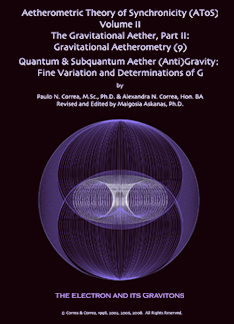![Akronos logo]](/images/akronos_wheel.jpg)
|
Akronos Publishing Concord, ON, Canada www.aetherometry.com |
![Akronos logo]](/images/akronos_wheel.jpg)
|
Akronos Publishing Concord, ON, Canada www.aetherometry.com |

The Gravitational Aether, Part II: Gravitational Aetherometry (9) -
Quantum and Subquantum Aether (Anti)Gravity:
Fine Variation and Determinations of G
by Correa, Paulo N. & Correa, Alexandra N.
Published in April 2008. 92 pages.
Aetherometric Theory of Synchronicity, Vol. 2
Monograph AS3-II.11
Price: US $80 ($30 ISFA)
|
ABSTRACT
The present communication has an ambitious reach. It describes in detail the fine subquantum structure of the Aether lattice, and identifies its
properties: the modal (or tendentially invariant) Planck's length, which is
an actual wavelength (λPlanck) of subquantum ambipolar charges whose flux
creates the lattice; the fundamental gyro-gravitational moment Thus, we are led to present a specifically aetherometric "cosmogenic production scenario". We suggest that these ultra-high energy, massfree ambipolar charges are the real cosmic primaries responsible for the ultra-high energy spectrum of cosmic rays (CR). We also indicate exactly how these tremendously energetic particles are released from the Aether lattice in the process of production of Matter and "cosmogenic radiation" (CBOR, mCBR and rCBR), by secondary superimposition of (2°) lattice elements derived from the energy of the (1°) ambipolar lattice constituents. Accordingly, our aetherometric model also explains how emission of gravitons from the Aether lattice accompanies the condensation of mass-energy and the emission of ultra-high energy ambipolar charges (CR primaries). Aside from the "production scenario", the outcome of this approach is a theory of the dual structure of gravitons (in phase-energy constructs and in "free transit"), the identification of their precise fine structure and geometry, and a model for the local, punctual variation of G. We examine the fine structure of the Aether lattice of space in all its phase energy configurations that produce either the 'universal invariant' G force or a bipolar variation that locally increases or decreases G. In particular, we focus on how leptonic and baryonic particle creation necessarily engages a local G increase, as opposed to the local G decrease expected when the lattice releases antigravitons instead. A total of 8 processes are isolated, and 14 distinct aetherometric functions (including those relating to the conversion of the Newton into the meter-second system units of force) are employed in the determination of the correct value of the 'invariant' G, whose simplest expressions is: G = λe/103 π2 (19,206)6 KkrSS = λPlanck KkrSS = also termed the aetherometric lawful value. This value of G is found to be remarkably close to the mean±SEM of 16 distinct numerical determinations: G = 1.107458228*10-35 m2 sec-2± 0.000273341 In the course of the investigation, the exact value of the so-called
'Planck's length' is determined as an instance of a wavelength function
shared by both gravitons (of either type, phase-graviton or transit
graviton) and the ultra-high energy ambipolar charges that modally
constitute the Aether lattice. We propose an exact value for the
invariant or modal Planck's length, and further propose that, whether the
length (function) is variable or invariant, G is always the product of that
length by m sec-2 (KkrSS = 1 m sec-2). We also identify a
gyro-gravitational moment
Clearly, These findings give rise to mutually consistent quantum and subquantum descriptions of the gravitational field and the ultimate energy structure of the Aether lattice. A search for the consistency of physical descriptions of the quantum and subquantum worlds cannot be reduced to or identified with a search for a theory of everything (TOE), or a search for a unified theory. Unification comes about after reduction, identification and generalization. Whereas consistency poses a different problematics than that required by the need for unification(s). Consistency poses the problem of the connectivity of the real, of the 'actual physical'. It is a matter of functional relations, of how energy converts into energy, and not a matter of reductions, identifications and probability states. Consistency requires a physics that thinks in terms of energy, not in terms of mass (mechanism), or in terms of space (relativity), or in terms of topology (probabilism). Only the concept of energy can consistently connect the senses of the physical world. An adequate quantum description or account cannot be such unless it is already compatible with - and adequate to - an also adequate subquantum account. What's adequate is a connection - the nexus - and not an operation of unification, reduction, identification. Lastly, but not least, our findings and proposed theoretical approach also lead to a new geometric and topological model of all gravitational energy units, and thus a novel energy-based treatement of the phenomena of gravity, gravitation and antigravity. We propose that there are two different families of gravitational energy units, or gravitons, whose detailed fine-structure geometry and wavefunctions we believe to have 'cracked': 1. A family of toroidal structures to which the phase-energy graviton belongs, and which can serve as energy storage (as in holding mass-energy together, or in free fall, etc). 2. A family of epicycloidal structures to which the primary gravitational energy swing and all 'transit' gravitons released from the lattice belong. Finally, a complementary model is proposed for the 'native state' of the entire Aether lattice based upon the intra-lattice interaction of ultra-high energy (1015 to 1042 eV) ambipolar charges, all other energy elements being but phase-resultants of the constant interactions of these ambipolar charges. In the lattice's 'native state' (modal or invariant state), the energy and fine structure of the ambipolar charges are given by: ELattice = |